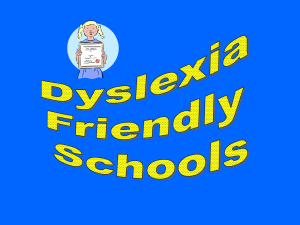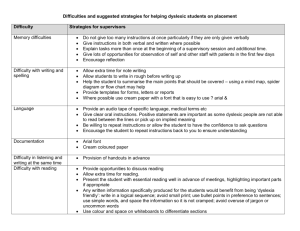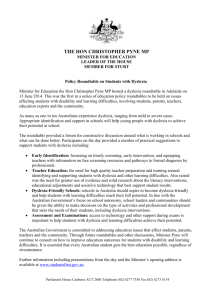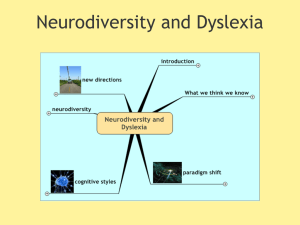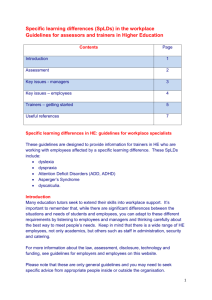Read publication - Kids can succeed
advertisement
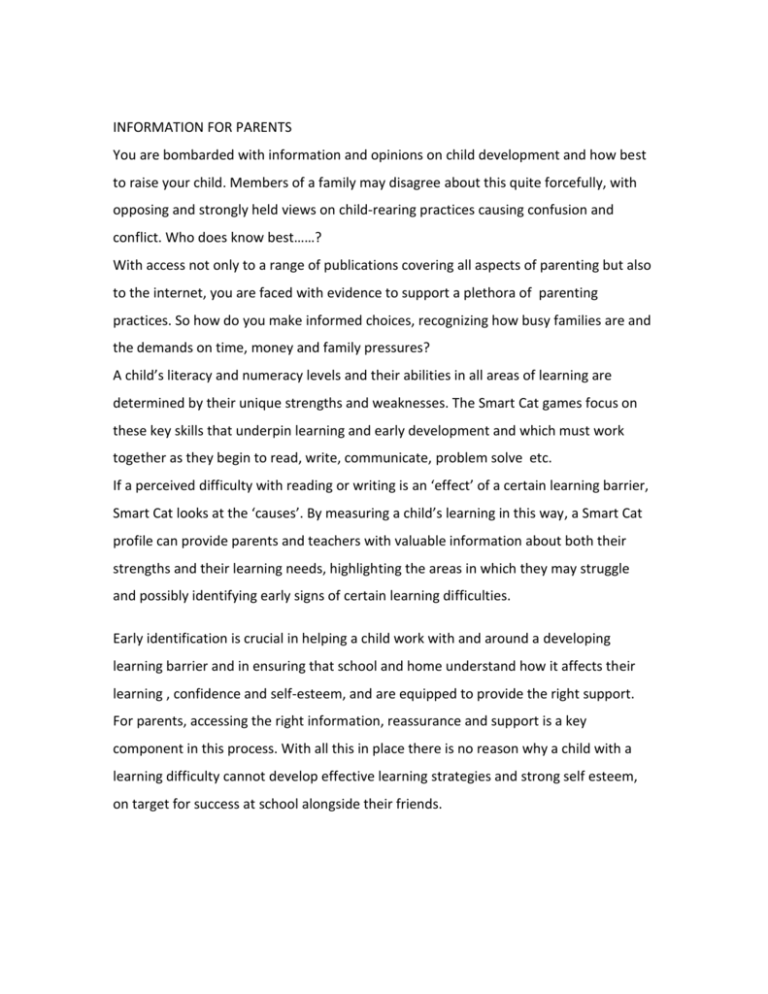
INFORMATION FOR PARENTS You are bombarded with information and opinions on child development and how best to raise your child. Members of a family may disagree about this quite forcefully, with opposing and strongly held views on child-rearing practices causing confusion and conflict. Who does know best……? With access not only to a range of publications covering all aspects of parenting but also to the internet, you are faced with evidence to support a plethora of parenting practices. So how do you make informed choices, recognizing how busy families are and the demands on time, money and family pressures? A child’s literacy and numeracy levels and their abilities in all areas of learning are determined by their unique strengths and weaknesses. The Smart Cat games focus on these key skills that underpin learning and early development and which must work together as they begin to read, write, communicate, problem solve etc. If a perceived difficulty with reading or writing is an ‘effect’ of a certain learning barrier, Smart Cat looks at the ‘causes’. By measuring a child’s learning in this way, a Smart Cat profile can provide parents and teachers with valuable information about both their strengths and their learning needs, highlighting the areas in which they may struggle and possibly identifying early signs of certain learning difficulties. Early identification is crucial in helping a child work with and around a developing learning barrier and in ensuring that school and home understand how it affects their learning , confidence and self-esteem, and are equipped to provide the right support. For parents, accessing the right information, reassurance and support is a key component in this process. With all this in place there is no reason why a child with a learning difficulty cannot develop effective learning strategies and strong self esteem, on target for success at school alongside their friends. What is it that Screen Learning can offer in this context? An assessment and support service based on sound research developed in consultation with psychologists, educators, specialists in additional learning needs and parents themselves Detailed reports linked to activities for parents to carry out as part of daily communication and activities with their child related directly to the Early Learning Goals An understanding of your child’s development in relation to national averages based on their Early Years Foundation Stage Profile Specialist support and guidance tailored to their own child for parents who are concerned by the results of the assessments or who have more generalized concerns about their child’s development A programme which recognizes that children develop at their own rate and that slow progress as measured against national averages becomes a concern only when the monitoring process identifies it as such. Parents do need to allow their child to progress as well as they are able to in a nurturing and loving environment which respects their individual profile without making comparisons with other children in the family. Who knows if your child is a future artist, actor or mathematician? The Screen Learning Profile is best used to develop your child’s overall development so that strengths are recognized and areas of development can be targeted through fun, practical activities. If you follow the advice provided on this web-site in addition to the information provided by your child’s educator, you are more likely to be creating optimal learning experiences which everyone will enjoy! INFORMATION ABOUT SPECIFIC LEARNING DIFFICULTIES Many of the following additional learning needs may not be reliably identified before the age of 7, however, early screening can heighten both parental and school awareness of potential difficulties as well as potential areas of strength and excellence. It is important that you do not form judgments based on snap-shots of your child’s performance and that you seek advice, taking your child’s whole profile into account. In addition to this, focus on what you know as a parent and your gut feelings about whether your child is failing to thrive. It is also important to note that children generally do not fall neatly into diagnostic categories and that the umbrella term specific learning difficulties,( SpLD) is used to cover a number of areas including: Dyslexia Dyscalculia Dyspraxia Dysgraphia Attention Deficit Disorder (ADD) and Attention Deficit Hyperactivity Disorder (ADHD) Asperger’s Syndrome Dyslexia Estimates vary between 4% and 10% of children in the UK experiencing dyslexic-type learning difficulties with reading, writing, short-term memory, sequencing, the manipulation of sounds ( phonological awareness) , spelling , general organization and the automatic development of skills that may not match up to an individual’s other cognitive abilities. Psychologists often describe developmental dyslexia as an ‘unexpected’ problem with learning to read and write, in that a child is having difficulty even though everything appears right for them to learn. There are a number of theories as to the causes of dyslexia; however it seems clear that children can experience dyslexic difficulties across a wide range of intelligence. Indeed some of the world’s great minds have been dyslexic, including Albert Einstein, Winston Churchill, Beethoven, JFK, Isaac Newton and Leonardo Di Vinci to name but a few. It is important for children and their families to adopt a positive attitude towards dyslexia; it is not a ‘condition’ and cannot be ‘cured’. If the appropriate learning methods are provided which are multi-sensory and indeed good practice for the majority of children, there is no reason why children with dyslexia cannot flourish. Dyslexia affects different children in different ways and it is because dyslexic difficulties manifest themselves in different ways that specialists point to the importance of establishing each child’s cognitive profile to find out where their unique learning strengths and weaknesses lie. Dyslexia can easily go undetected in early schooling. Children can become frustrated by the difficulty in learning to read and they may show signs of low self-esteem and behaviourial problems which develop out of frustration. Some Indicators of Dyslexia in Pupils of Pre-School Age Inconsistent performance: sometimes cannot remember the names of objects such as ‘computer’. Difficulty learning nursery rhymes Jumbles up words and phrases Delayed speech development May have walked early, but did not crawl Difficulties with clapping rhythms, motor coordination skills Difficulties with getting dressed and putting shoes on correct feet Excessive tripping, bumping into things and falling over (Source: British Dyslexia Association) If these signs are evident in your child while in other ways they are bright and alert, it is possible that you are seeing some of the early indicators of a dyslexic type learning difficulty. How the Smart Cat Learning Profile can help Your child’s Smart Cat Learning profile may be used as a dyslexia pre-screener to see if they struggled with some of the key skills that are often affected by a dyslexic type difficulty. 1. Did they produce a particularly low score in the sound matching game ‘Words and Sounds’? This game looks at a child’s ability to identify and order component sounds within words, an activity with which a child with dyslexia is likely to struggle. 2. Difficulties in visual short term memory may also be associated with dyslexia. The sequencing game, ‘Singing Cats’ and short term memory game ‘Cool Cards’ both measure a child’s ability to register and remember sequences and organize information in their head to then reproduce it on the screen. Low scores in these games may indicate a difficulty here. 3. Weaknesses in fine motor skills often co-occur with dyslexia and the ‘Feed the Cat’ game is a timed drag and drop activity that dyslexic children may struggle to score well on. If aspects of the above apply to your child, there are various steps you can take including seeking check-ups from the appropriate agencies. Is there possibly an underlying visual problem? Howe well did they perform on the colour vision game, ‘Magic Shapes?’ Is there any indication of hearing difficulties and a history of this? Speak to your child’s teacher, bring your concerns to their attention and ask if they have noticed some of the same signs and what advice they may have. The school will have a Special Educational Needs Co-coordinator (SENCO) whose role is specifically to support children in these areas. Schools often have access to a range of programs to pinpoint areas of difficulty and it is important that your child has access to appropriate screening and assessment. In the Links page of this site you will find a list of agencies and organizations set up specifically to provide information and support to people of all ages affected by dyslexia. If necessary, and when other routes have been explored , a full assessment can be made by an Educational Psychologist. They will be able confirm if your child does present with a dyslexic profile and they will provide you and the school with guidance on appropriate interventions. Referral to an Educational Psychologist is made either through your child’s school as part of the staged SEN Code of Practice or there are private options. In the meantime your child’s Smart Cat activity recommendations are specifically tailored to support their learning needs and will provide fun and focused steps to help you help them access their strengths as well as focus on their weaknesses. Whatever the outcome, be reassured that by identifying your child’s learning strengths and areas for development early you are putting the first blocks into place to best support their learning, boost their self esteem and unlock their true potential. Dyscalculia Dyscalculia relates to difficulties with: Mathematical skills Reversals and omissions of numbers Concepts of time , sense of direction Following sequential instructions and spatial orientation How the Smart Cat Learning Profile can help A child with difficulties of this type may produce low scores on the following: 1. Magic Pictures: This is a game relating to following increasingly complex instructions 2. Where is Tiny Mouse? : This game investigates spatial awareness. 3. How Many? : As mathematical problems are a key feature of dyscalculia, it is likely that there will be a low score on this game. 4. Singing Cats: As this game assesses sequencing ability, it is likely to present some challenges to a child with a dyscalculia difficulties. If aspects of the above apply to your child, there are various steps you can take including seeking check-ups from the appropriate agencies. Speak to your child’s teacher, bring your concerns to their attention and ask if they have noticed some of the same signs and what advice they may have. The school will have a Special Educational Needs Co-coordinator (SENCO) whose role is specifically to support children in these areas. Schools will probably want to monitor progress and development for a period of time before suggesting additional action/ provision. In the Links page of this site you will find a list of agencies and organizations set up specifically to provide information and support to people of all ages affected by dyslexia and dyscalculia. If necessary, and when other routes have been explored, a full assessment can be made by an Educational Psychologist. They will be able confirm if your child does present with dyscalculia and they will provide you and the school with guidance on appropriate interventions. Referral to an Educational Psychologist is made either through your child’s school as part of the staged SEN Code of Practice or there are private options. In the meantime your child’s Smart Cat activity recommendations are specifically tailored to support their learning needs and will provide fun and focused steps to help you help them access their strengths as well as focus on their weaknesses. Whatever the outcome, be reassured that by identifying your child’s learning strengths and areas for development early you are putting the first blocks into place to best support their learning, boost their self esteem and unlock their true potential. Dyspraxia Dyspraxia, also known as developmental coordination disorder (DCD) is often evident from an early age as follows: Babies may be irritable from birth and have significant feeding problems. Slow to achieve developmental milestones such as sitting independently May not crawl. More likely to be a ‘bottom shuffler’. Some Indicators of Dyspraxia in Pupils of Pre-School Age Very high levels of motor activity, including feet swinging and tapping when seated, hand-clapping or twisting. Unable to stay still High levels of excitability, with a loud/shrill voice May be easily distressed and prone to temper tantrums May constantly bump into objects and fall over Hands flap when running Difficulty with pedalling a tricycle or similar toy Lack of any sense of danger (jumping from heights etc) Continued messy eating. May prefer to eat with their fingers, frequently spill drinks Avoidance of constructional toys, such as jigsaws or building blocks Poor fine motor skills. Difficulty in holding a pencil or using scissors. Drawings may appear immature Lack of imaginative play. May show little interest in dressing up with limited creative play and isolation within the peer group. Laterality (left- or right-handedness) still not established Persistent language difficulties Sensitive to sensory stimulation, including high levels of noise, tactile defensiveness, wearing new clothes Limited response to verbal instruction. May be slow to respond and have problems with comprehension Limited concentration. Tasks are often left unfinished (Source: The Dyspraxia Foundation: www.dyspraxiafoundation.org.uk) How the Smart Cat Learning Profile can help Your child’s Smart Cat Learning profile may be used to support a concern that your child is showing some indicators of dyspraxia. 1. Did they produce a particularly low score on Feed the Cat, which assesses fine motor skills is a timed drag and drop activity? Fine motor control, hand-eye coordination and organization can be affected in children with a dyspraxic profile. 2. A low score on Sound Matching and Language Comprehension may also indicate difficulties of dyspraxia or an overlap of dyslexia and dyspraxia. 3. Where is Tiny Mouse? is a game relating to spatial awareness and children with dyspraxic difficulties may have difficulty with positional language and with recalling the information. 4. Fine motor control difficulties may cause low scores on Cat Toys. If aspects of the above apply to your child, there are various steps you can take including seeking check-ups from the appropriate agencies. Speak to your child’s teacher, bring your concerns to their attention and ask if they have noticed some of the same signs and what advice they may have. The school will have a Special Educational Needs Co-coordinator (SENCO) whose role is specifically to support children in these areas. Schools often have access to a range of programs to pinpoint areas of difficulty and it is important that your child has access to appropriate screening and assessment. In the Links page of this site you will find a list of agencies and organizations set up specifically to provide information and support to people of all ages affected by dyspraxia. If necessary, a full assessment can be made by an Educational Psychologist. They will be able confirm if your child does present with a dyspraxic profile and they will provide you and the school with guidance on appropriate interventions. Referral to an Educational Psychologist is made either through your child’s school as part of the staged SEN Code of Practice or there are private options. In the meantime your child’s Smart Cat activity recommendations are specifically tailored to support their learning needs and will provide fun and focused steps to help you help them access their strengths as well as focus on their weaknesses. Whatever the outcome, be reassured that by identifying your child’s learning strengths and areas for development early you are putting the first blocks into place to best support their learning, boost their self esteem and unlock their true potential. Dysgraphia Dysgraphia is a difficulty in writing which may be associated with a generalized lack of coordination and well-developed fine motor skills. Dysgraphia is often linked to dyspraxia: see above. ADD / ADHD Attention Deficit Disorder, with or without Hyperactivity is associated with the following traits: Inattentiveness Impulsiveness Poor learning and social skills Hyperactivity: the inability to control the amount of physical activity appropriate to a situation. In early years’ settings and at home this might manifest itself in the following ways: Temper tantrums Clumsiness Confrontational behaviour Learning Difficulties Fidgets, squirms : unable to stay on a seat Struggles in group situations and interrupts games etc How the Smart Cat Learning Profile can help Your child’s Smart Cat Learning profile may be used to support a concern that your child is showing some indicators of ADD / ADHD, although great caution should be exercised over pacing undue emphasis on this one pre-screener. It is possible that you have already sought medical advice as there are defined criteria for a diagnosis of ADD/ ADHD. 1. Are the scores erratic such that no pattern of strengths or weaknesses is apparent? A child who may be exhibiting some traits associated with a possible diagnosis of ADD/ ADHD may experience great difficulty with conforming to the tasks, even though these are games-based. 2. Has hearing and vision been checked? 3. Has your child’s diet and related allergies / additives intolerance been investigated? 4. If you have concerns about your child in this respect, you are advised to contact the school and to seek medical advice. In the meantime your child’s Smart Cat activity recommendations are specifically tailored to support their learning needs and will provide fun and focused steps to help you help them access their strengths as well as focus on their weaknesses. Whatever the outcome, be reassured that by identifying your child’s learning strengths and areas for development early you are putting the first blocks into place to best support their learning, boost their self esteem and unlock their true potential. Asperger’s Syndrome (The following information is adapted from The National Autistic Society Web-site) Asperger Syndrome is a form of autism, which is a lifelong disability that affects how a person makes sense of the world, processes information and relates to other people. The exact cause of Asperger Syndrome is still being investigated. However, research suggests that a combination of factors - genetic and environmental - may account for changes in brain development. Asperger Syndrome is not caused by a person's upbringing, their social circumstances and is not the fault of the individual with the condition. Some Indicators of Asperger’s Syndrome in Pupils of Pre-School Age Difficulty understanding gestures, facial expressions or tone of voice Difficulty in expressing themselves emotionally and socially Social communication: understanding how games are played and following the subtle ‘rules’ of games Understanding or interpreting other peoples thoughts, feelings or actions. The subtle messages that are put across by facial expression and body language are often missed Some children with Asperger Syndrome may find it difficult to play 'let's pretend' games or prefer subjects rooted in logic and systems, such as mathematics. Sensory difficulties which can occur in one or all of the senses (sight, sound, smell, touch, or taste). Most commonly, an individual's senses are either intensified (over-sensitive) or underdeveloped (under-sensitive). Bright lights, loud noises, overpowering smells, particular food textures and the feeling of certain materials can be a cause of anxiety and pain for people with Asperger syndrome. How the Smart Cat Learning Profile can help It is likely that a child presenting with a possible diagnosis of Asperger’s Syndrome will already have been identified as causing concern. Their performance on the games should be therefore be observed closely, particularly in relation to the use of headphones as this may cause them discomfort or distress if they are hypersensitive to sound ( see above). It is likely that your child will experience difficulties with the following games: 1. Cats in Bins and Singing Cats: It is possible that this game will cause discomfort as they may dislike the sounds. 2. Which Mousehole? This game assesses the ability to understand that other people’s ideas of the world may be different to their own. Children with Asperger’s Syndrome often have difficulty with ‘reading someone else’s mind’. 3. Happy Cats: This assesses a child’s ability to recognize emotions and feelings in others and it helps to identify children who may have impairments of social awareness. In the meantime your child’s Smart Cat activity recommendations are specifically tailored to support their learning needs and will provide fun and focused steps to help you help them access their strengths as well as focus on their weaknesses. Whatever the outcome, be reassured that by identifying your child’s learning strengths and areas for development early you are putting the first blocks into place to best support their learning, boost their self esteem and unlock their true potential. Further Information Over the past twelve or so years a number of specific learning difficulties have been identified, labeled and researched. These include Asperger’s syndrome, ADD, ADHD, dyspraxia, semantic pragmatic language disorder and dyscalculia. A child may exhibit the characteristics of just one of these, but there is a strong chance that more than one ‘condition’ will apply. Difficulties often occur together and this may be causal, independent or due to similar underlying aetiologies. This may be of theoretical interest to the teacher, but the manifestations of the difficulties in the classroom should be more pertinent. My guess is that the interventions used for one disorder may very well impact on all disorders and their various combinations. This is not to say that one programme of intervention will help all children. It is far more subtle than that, but the basic principle, stated by workers such as Dr Harry Chasty in the UK and Dr Margaret Rawson in the USA, is ‘If the child doesn’t learn the way you teach, can you teach the way he learns?’ (The Standards Site: Mathematics, dyslexia and dyscalculia)

